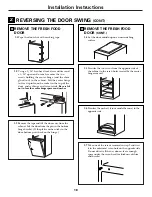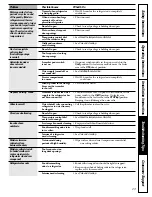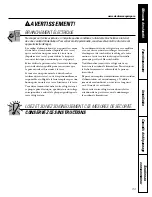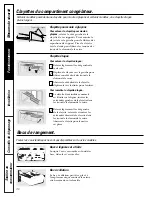
■
The new high efficiency
compressor may run
faster and longer than
your old refrigerator
and you may hear a high-pitched hum or pulsating
sound while it is operating.
■
You may hear a whooshing sound when the doors close.
This is due to pressure equalizing within the refrigerator.
Normal operating sounds.
Newer refrigerators sound different from older refrigerators. Modern refrigerators have more features
and use newer technology.
■
You may hear the fans spinning at
high speeds.
This happens when the refrigerator
is first plugged in, when the doors
are opened frequently or when
a large amount of food is added to the refrigerator or
freezer compartments. The fans are helping to
maintain the correct temperatures.
CLICKS, POPS,
CRACKS and CHIRPS
■
You may hear cracking or popping sounds when the
refrigerator is first plugged in. This happens as the
refrigerator cools to the correct temperature.
■
The compressor may cause a clicking or chirping sound
when attempting to restart (this could take
up to 5 minutes).
■
Expansion and contraction of cooling coils during and
after defrost can cause a cracking or popping sound.
■
On models with an icemaker, after an icemaking cycle, you
may hear the ice cubes dropping into the ice bucket.
WATER SOUNDS
■
The flow of refrigerant through the freezer cooling coils
may make a gurgling noise like boiling water.
■
Water dropping on the defrost heater can cause a sizzling,
popping or buzzing sound during the defrost cycle.
■
A water dripping noise may occur during the defrost cycle as
ice melts from the evaporator and flows into the drain pan.
■
Closing the door may cause a gurgling sound due to
pressure equalization.
Do you hear what I hear? These sounds are normal.
For additional information on normal
icemaker operating sounds, see the
About the automatic icemaker
section.
22
Consumer Support
Tr
oubleshooting T
ips
Operating Instructions
Safety Instructions
Installation Instructions
Before you call for service…
Troubleshooting Tips
Save time and money! Review the charts on the following
pages first and you may not need to call for service.
Problem
Possible Causes
What To Do
Refrigerator does not
Refrigerator in defrost cycle.
•
Wait about 30 minutes for defrost cycle to end.
operate
Temperature control dial
•
Move the temperature control dial to a temperature
in
0
position.
setting.
Refrigerator is unplugged.
•
Push the plug completely into the outlet.
The fuse is blown/circuit
•
Replace fuse or reset the breaker.
breaker is tripped.
Vibration or rattling (slight
Roller screws or leveling legs
•
See
Rollers and Leveling Legs.
vibration is normal)
need adjusting.
Fresh food or freezer
Temperature control dial
•
See
About the temperature control dial.
compartment too warm
not set cold enough.
Warm weather or frequent
•
Set the temperature control dial one step colder.
door openings.
See
About the temperature control dial.
Door left open.
•
Check to see if package is holding door open.
Package blocking air duct in
•
Check to see if package is blocking air duct in freezer
freezer compartment.
compartment.
HUMMM...
WHOOSH...
Summary of Contents for TOP-FREEZER 16
Page 26: ...26...
















































